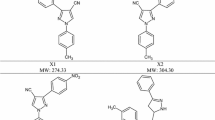Abstract
Orpanoxin, a nonsteroidal anti-inflammatory drug (NSAID) lacking gastric ulcerogenic effects in the therapeutic dose range in rats, was compared with six reference NSAIDs for oral activity in the rat paw carrageenim-induced edema assay. Tested NSAIDs were ranked on the basis of oral mg/kg ED50 values: piroxicam, 0.55; orpanoxin, 35.6; diflunisal, 59.6; benoxaprofen, >300; tolmetin sodium, >300; and sulindae, >300. Zomepirac sodium was inactive. Only the three most potent compounds produced greater than 60% inhibition of edema. Inhibition was generally greater at 4 h than at 6 h post carrageenin for all compounds. Oral activity of orpanoxin was also demonstrated in the guinea-pig u.v.-induced erythema model (ED50=24.2 mg/kg p.o. when given 1 h before irradiation) and in the mouse ear eroton oil induced edema test (ED50 value = 131 mg/kg p.o.).
Topical activity of orpanoxin was assessed in both the guinea-pig and mouse models. In the guinea-pig u.v.-induced erythema model, application (1 h after u.v.) of 1, 5, and 10% (w/v) orpanoxin creams (containing 10% urea) significantly inhibited erythema at 2, 3, and 4 h post-irradiation. Orpanoxin, mefenamic acid, and indomethacin as 1% creams inhibited total erythema scores 70,92 and 74%, respectively. Evidence for topical activity in the mouse ear assay was also obtained for orpanoxin in diethyl ether or 10% urea cream, but not in dimethylsulfoxide. It was concluded that orpanoxin has anti-inflammatory activity comparable to reference NSAIDs in the rat paw edema test, is active orally in rat, mouse, and guinea-pig models, and shows topical activity in the guinea-pig and the mouse.
Similar content being viewed by others

References
M.M. Goldenberg, K.L. Boise andA>C. Ilse,Evaluation of a new anti-inflammatory/analgesic compound F-776, 5-(4-chlorophenyl)-β-hydroxy-2-furanpropanoic acid, Archs int. Pharmacodyn. Thér.243, 331–350 (1980).
R.R. Brooks, K.R. Bonk andK.E. Miller,Oral and topical anti-inflammatory activity of orpanoxin in rodents, Pharmacologist25, 235 (1983).
Norwich Eaton Pharmaceuticals, Inc., Alphaderm®. InPhysician's Desk Reference, 38th edn. Medical Economics Co., Inc., Oradell, NJ, 1984.
C.A. Winter, E.A. Risley andG.V. Nuss,Carrageenin-induced edema in the hindpaw of the rat as an assay for anti-inflammatory drugs, Proc. Soc. exp. Biol. Med.111, 544–547 (1962).
R.G.D. Steel andJ.E. Torrie,Principles and Procedures of Statistics. McGraw-Hill, New York 1960.
C.V. Winder, J. Wax, V. Burr, M. Been andC.E. Rosiere,A study of pharmacological influences on ultraviolet erythema in guinea pigs, Archs int. Pharmacodyn. Thér.116, 261–292 (1958).
Y. Iizuka, Y. Endo, Y. Misawa andE. Misaka,Two simple methods for the evaluation of topically active anti-inflammatory steroidal ointments, Agents and Actions11, 254–259 (1981).
P. Peters, C. Cooper, K. Maiorana andM.L. Graeme,The effect of topically applied agents on ultraviolet erythema in guinea pigs, Agents and Actions7, 545–553 (1977).
M. DiRosa, J.P. Giroud andD.A. Willoughby,Studies of the mediators of the acute inflammatory response induced in rats in different sites by carrageenin and turpentine. J. Path.104, 15–29 (1971).
C.T. Huang andK.O. Ellis,Inhibition of prostaglandin synthetase by F-776, 5-(4-chlorophenyl)-β-hydroxy-3-furanpropanoic acid, a new anti-inflammatory/analgesic compound, Biochem. Pharmac.30, 3008–3009 (1981).
G. Wilhelmi,Uber die pharmakologischen Eigenschaften von Irgapyrin einem Präparat aus der Pyrazolreihe, Schweiz. med. Wschr.79, 489–506 (1949).
M.E. Goldyne,Prostaglandins and cutaneous inflammation. J. invest. Derm.64, 377–385 (1975).
M.W. Greaves andJ. Sondergaard,Pharmacological agents released in ultraviolet inflammation studied by continuous skin perfusion. J. invest. Derm.54, 365–367 (1970).
G.P. Muthur andV.M. Gandi,Prostaglandin in human and albino rat skin. J. invest. Derm.58, 291–295 (1972).
D.A. Snyder andW.H. Eaglstein,Intradermal anti-prostaglandin agents and sunburn, J. Invest. Derm.62, 47–50 (1974).
E. Law andA.J. Lewis,The effect of systemically and topically applied drugs on ultraviolet-induced erythema in the rat. Br. J. Pharm.59, 591–597 (1977).
K.H. Kaidbry andA.K. Kurban,The influence of corticosteroids and topical indomethacin on sunburn erythema. J. invest. Derm.66, 153–156 (1976).
Author information
Authors and Affiliations
Rights and permissions
About this article
Cite this article
Brooks, R.R., Bonk, K.R., Decker, G.E. et al. Anti-inflammatory activity of orpanoxin administered orally and topically to rodents. Agents and Actions 16, 369–376 (1985). https://doi.org/10.1007/BF01982875
Received:
Accepted:
Issue Date:
DOI: https://doi.org/10.1007/BF01982875



